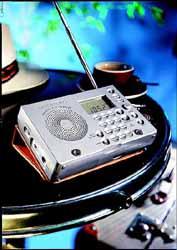
Year Introduced: 1997 (Re-tested 2001)
Power: 4.5 VDC (3 AA batteries)
Size: 135 by 89 by 35 mm
Weight: 400 g (with batteries)
Price €146, £89.95
USA version G2000A $99.95
Coverage MW, SW 2.3-26.1 MH
Value Rating star:
Europe

Elsewhere 
RADIO NETHERLANDS RECEIVER TEST LABORATORY: FULL REVIEW
This review was compiled independently. The Medium Wave Circle and Radio Netherlands has no financial connection with R.L. Drake, the manufacturer of this receiver.
In the course of the decades there have been few ‘designer’ label short-wave radios, although many will argue that some of the early transistor sets like the Zenith TransOceanic performed as well as they looked.
At the Funkausstellung in Germany at the end of August 1997, Grundig launched a short-wave receiver designed by F.A.Porsche. They have commissioned the same designer to make special versions of other Grundig products, but thus far the designer has only tackled one of the short-wave portables from this German company. In the past few years, Grundig has sourced some of its receivers in the Peoples’ Republic of China or from the Taiwanese company of Sangean (which has its own manufacturing plant in the Peoples’ Republic of China too). Grundig North America tends to operate independently from Grundig in Europe, leading to some differences in the short-wave portable range on both sides of the Atlantic. This time, it is Grundig in Europe that has taken initiative.
Although clearly sourced in China, this new P-2000 has been made by taking features from some existing receivers and adding extra features. So it is more than just a standard model radio put in a fancy silver plastic case.
The P-2000 is a travel portable measuring 135 by 89 by 35 mm. Three penlight batteries snap fit into a compartment in the base of the receiver. The set weighs 400 grams with batteries, but without the heavy-duty leather protective case which folds over the front to protect the keypad. This case leaves the power button, Liquid Crystal Display and the loudspeaker grill free when the flap is folded over.
There are two tiny slider switches inside the battery compartment. One selects the 9 or 10 kHz channel spacing for mediumwave. In the America’s and the Caribbean 10 kHz is the norm, elsewhere stations are separated by just 9 kHz. It is important to set this switch correctly because this set has no fine-tuning. Using the 10 kHz raster in Europe means that a station on 1395 kHz appears as 1390 or 1400 kHz and is seriously distorted as a consequence of being off tune.
The second switch selects the type of short-wave coverage. In one position, the set covers 2.3-7.4 and 9.4 – 26.1 MHz, split over two bands. If utility listening is not relevant (and this receiver has no provision for single-sideband) then you can also select to simply tune the broadcast sections with the range 2.3-26.1 MHz. As the receiver gets to the top end of the 22 metre band on 13900 kHz it springs to 14950 kHz, the bottom end of the 19 metre band. The manufacturer has made allowances for most stations that operate just outside the “official” short-wave broadcast bands.
The P-2000 offers direct frequency entry using a keypad. The indented design means that it is easy for a blind person to feel the keys and get orientation. There are also two keys to move up and down the bands. On mediumwave that is in 9 or 10 kHz steps, on short-wave the spacing is 5 kHz and on FM 50 kHz. Reception on FM can be in stereo, or selected to mono in weaker signal areas.
The 5 kHz spacing on short wave is adequate, but a fine tuning control would have been handy. Experience shows that when you want to listen to a weak station that is 5 kHz away from a stronger signal, slightly off tuning can help you escape interference from the stronger station. The liquid crystal display, which can be illuminated in the dark, shows the time when the radio is switched off, and the frequency when switched on. Since the tuning steps on short-wave are 5 kHz apart, the last figure on the display is shown as a smaller 5, when relevant.
AVERAGE RECEPTION
Performance on short wave turned out to be only average for a set of this type, certainly no surprises. Sensitivity is good across the lower short-wave broadcast bands, tapering off slightly above 15 MHz. The single bandwidth filter is well matched to the audio amplifier. The set sounds crisp. Like all sets of this type, it can overload with the high signal levels encountered in Europe. But a simple remedy is to retract the telescopic whip to reduce how much signal gets into the radio.
The set has two clocks, which is useful for travelling, and a built-in alarm. You can either wake up to a preselected radio station or a buzz. The power button protrudes from the case and switches on easily. In a suitcase, the set will almost always spring to life. Luckily there is a lock slider switch to prevent this happening.
In short, this receiver is a reasonable entry level portable. At 250 Guilders this receiver offers only fair value in The Netherlands. It is seen elsewhere in Europe for around the same price (approx. US$120). The design is likely to appeal to collectors. Outside Europe the radio turns out to be far more expensive and thus poor value.
In North America, this portable carries the model number G2000A.
This review first appeared on the Radio Netherlands website.